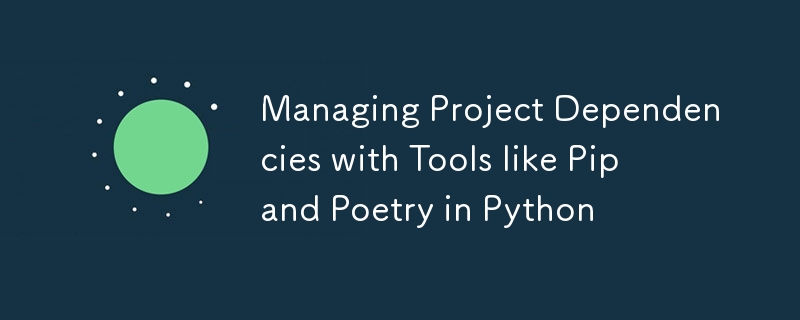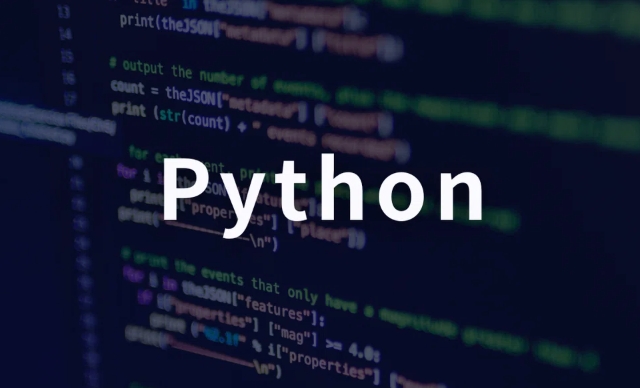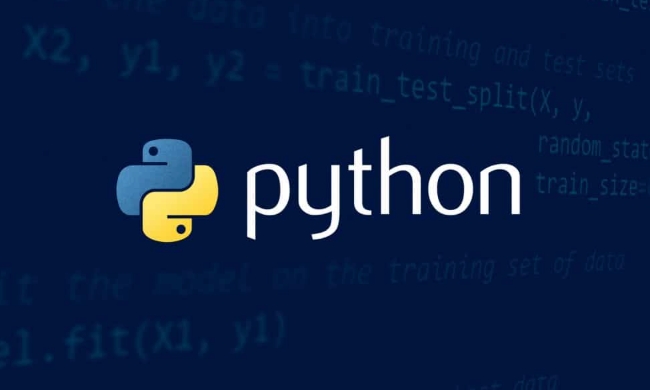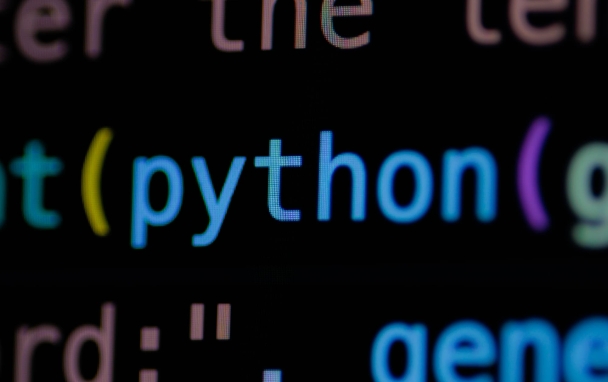 Backend Development
Backend Development
 Python Tutorial
Python Tutorial
 Managing Project Dependencies with Tools like Pip and Poetry in Python
Managing Project Dependencies with Tools like Pip and Poetry in Python
Key tools for Python project dependency management are Pip and Poetry. 1. Pip is suitable for small projects with requirements.txt. It installs dependencies through pip install -r requirements.txt, but it is difficult to separate the production and production environment. 2. Poetry is a more modern tool that automatically creates virtual environments, uses pyproject.toml and poetry.lock to accurately lock dependency versions, supports development of dependency markups (such as poetry add --dev pytest), and can build publishing packages. 3. Choose based on project complexity: Use Pip for simple scripts, and recommend Poetry for professional projects to improve stability and reproducibility.

Python project dependency management is a key part of the development process, especially when teams collaborate or deployed to different environments. Using tools like Pip and Poetry can help you more clearly control the various library versions required by the project, avoiding problems such as environmental chaos and version conflicts.

What is project dependency?
Simply put, dependencies are the third-party libraries necessary for your project to run. For example, if you write a web application and use Flask, then Flask is one of your dependencies. Sometimes these dependencies also have their own dependencies (called sub-dependencies), and it is easy to make mistakes when managed manually. At this time, tools are needed to help.

Pip requirements.txt: The most basic approach
If you are just starting to get involved in Python project management, you may have used pip install -r requirements.txt .
- All packages and versions that need to be installed are listed in the
requirements.txtfile, such as:flask==2.3.0 requests>=2.28.1
Advantages : Simple and direct, suitable for small projects or quick testing.

Disadvantages : It cannot handle the separation of development dependencies and production dependencies well, and does not support functions such as automatic creation of virtual environments.
Tips: Use
pip freeze > requirements.txtto export all dependencies of the current environment, but be aware that this method will write all installed packages into it, which may contain content you do not want.
Poetry: A more modern way of dependency management
Poetry is a dependency management and packaging tool designed specifically for Python. It not only helps you manage dependencies, but also helps you build and publish your own packages.
Installation and initialization
You can install Poetry through the officially recommended method:
curl -sSL https://install.python-poetry.org | python3 -
Then run in the project root directory:
poetry init
This will guide you to create a pyproject.toml file that records the basic information and dependencies of the project.
Adding dependencies is simple
Want to add a dependency? Run directly:
poetry add flask
Poetry will automatically download the latest version and update pyproject.toml and a lock file called poetry.lock . The latter ensures that you install the exact same version combination on different machines.
Separate the dependency
Some packages are only used in the development stage, such as pytest and black. Poetry allows you to specifically tag them as "dev" dependencies:
poetry add --dev pytest
This allows you to choose not to install these dependencies when deploying a production environment:
poetry install --no-dev
How to choose Pip or Poetry?
This problem actually depends on the size and complexity of your project:
- If you just write a small script or use it for teaching, Pip plus requirements.txt is enough.
- If you want to better manage dependency trees, lock versions, or even prepare for package releases, then use Poetry.
In addition, Poetry also supports generation of traditional distribution formats such as setup.py and wheel, and it is easier to integrate CI/CD processes.
In general, whether it is Pip or Poetry, the key is to establish a clear dependency management process. Don't wait until it is launched to find that a certain version has changed and causes the program to report an error. Using these tools well can make your project more stable and reproducible.
Basically that's it.
The above is the detailed content of Managing Project Dependencies with Tools like Pip and Poetry in Python. For more information, please follow other related articles on the PHP Chinese website!

Hot AI Tools

Undress AI Tool
Undress images for free

Undresser.AI Undress
AI-powered app for creating realistic nude photos

AI Clothes Remover
Online AI tool for removing clothes from photos.

Clothoff.io
AI clothes remover

Video Face Swap
Swap faces in any video effortlessly with our completely free AI face swap tool!

Hot Article

Hot Tools

Notepad++7.3.1
Easy-to-use and free code editor

SublimeText3 Chinese version
Chinese version, very easy to use

Zend Studio 13.0.1
Powerful PHP integrated development environment

Dreamweaver CS6
Visual web development tools

SublimeText3 Mac version
God-level code editing software (SublimeText3)

Hot Topics
 How does Python's unittest or pytest framework facilitate automated testing?
Jun 19, 2025 am 01:10 AM
How does Python's unittest or pytest framework facilitate automated testing?
Jun 19, 2025 am 01:10 AM
Python's unittest and pytest are two widely used testing frameworks that simplify the writing, organizing and running of automated tests. 1. Both support automatic discovery of test cases and provide a clear test structure: unittest defines tests by inheriting the TestCase class and starting with test\_; pytest is more concise, just need a function starting with test\_. 2. They all have built-in assertion support: unittest provides assertEqual, assertTrue and other methods, while pytest uses an enhanced assert statement to automatically display the failure details. 3. All have mechanisms for handling test preparation and cleaning: un
 How can Python be used for data analysis and manipulation with libraries like NumPy and Pandas?
Jun 19, 2025 am 01:04 AM
How can Python be used for data analysis and manipulation with libraries like NumPy and Pandas?
Jun 19, 2025 am 01:04 AM
PythonisidealfordataanalysisduetoNumPyandPandas.1)NumPyexcelsatnumericalcomputationswithfast,multi-dimensionalarraysandvectorizedoperationslikenp.sqrt().2)PandashandlesstructureddatawithSeriesandDataFrames,supportingtaskslikeloading,cleaning,filterin
 What are dynamic programming techniques, and how do I use them in Python?
Jun 20, 2025 am 12:57 AM
What are dynamic programming techniques, and how do I use them in Python?
Jun 20, 2025 am 12:57 AM
Dynamic programming (DP) optimizes the solution process by breaking down complex problems into simpler subproblems and storing their results to avoid repeated calculations. There are two main methods: 1. Top-down (memorization): recursively decompose the problem and use cache to store intermediate results; 2. Bottom-up (table): Iteratively build solutions from the basic situation. Suitable for scenarios where maximum/minimum values, optimal solutions or overlapping subproblems are required, such as Fibonacci sequences, backpacking problems, etc. In Python, it can be implemented through decorators or arrays, and attention should be paid to identifying recursive relationships, defining the benchmark situation, and optimizing the complexity of space.
 How can you implement custom iterators in Python using __iter__ and __next__?
Jun 19, 2025 am 01:12 AM
How can you implement custom iterators in Python using __iter__ and __next__?
Jun 19, 2025 am 01:12 AM
To implement a custom iterator, you need to define the __iter__ and __next__ methods in the class. ① The __iter__ method returns the iterator object itself, usually self, to be compatible with iterative environments such as for loops; ② The __next__ method controls the value of each iteration, returns the next element in the sequence, and when there are no more items, StopIteration exception should be thrown; ③ The status must be tracked correctly and the termination conditions must be set to avoid infinite loops; ④ Complex logic such as file line filtering, and pay attention to resource cleaning and memory management; ⑤ For simple logic, you can consider using the generator function yield instead, but you need to choose a suitable method based on the specific scenario.
 What are the emerging trends or future directions in the Python programming language and its ecosystem?
Jun 19, 2025 am 01:09 AM
What are the emerging trends or future directions in the Python programming language and its ecosystem?
Jun 19, 2025 am 01:09 AM
Future trends in Python include performance optimization, stronger type prompts, the rise of alternative runtimes, and the continued growth of the AI/ML field. First, CPython continues to optimize, improving performance through faster startup time, function call optimization and proposed integer operations; second, type prompts are deeply integrated into languages ??and toolchains to enhance code security and development experience; third, alternative runtimes such as PyScript and Nuitka provide new functions and performance advantages; finally, the fields of AI and data science continue to expand, and emerging libraries promote more efficient development and integration. These trends indicate that Python is constantly adapting to technological changes and maintaining its leading position.
 How do I perform network programming in Python using sockets?
Jun 20, 2025 am 12:56 AM
How do I perform network programming in Python using sockets?
Jun 20, 2025 am 12:56 AM
Python's socket module is the basis of network programming, providing low-level network communication functions, suitable for building client and server applications. To set up a basic TCP server, you need to use socket.socket() to create objects, bind addresses and ports, call .listen() to listen for connections, and accept client connections through .accept(). To build a TCP client, you need to create a socket object and call .connect() to connect to the server, then use .sendall() to send data and .recv() to receive responses. To handle multiple clients, you can use 1. Threads: start a new thread every time you connect; 2. Asynchronous I/O: For example, the asyncio library can achieve non-blocking communication. Things to note
 Polymorphism in python classes
Jul 05, 2025 am 02:58 AM
Polymorphism in python classes
Jul 05, 2025 am 02:58 AM
Polymorphism is a core concept in Python object-oriented programming, referring to "one interface, multiple implementations", allowing for unified processing of different types of objects. 1. Polymorphism is implemented through method rewriting. Subclasses can redefine parent class methods. For example, the spoke() method of Animal class has different implementations in Dog and Cat subclasses. 2. The practical uses of polymorphism include simplifying the code structure and enhancing scalability, such as calling the draw() method uniformly in the graphical drawing program, or handling the common behavior of different characters in game development. 3. Python implementation polymorphism needs to satisfy: the parent class defines a method, and the child class overrides the method, but does not require inheritance of the same parent class. As long as the object implements the same method, this is called the "duck type". 4. Things to note include the maintenance
 How do I slice a list in Python?
Jun 20, 2025 am 12:51 AM
How do I slice a list in Python?
Jun 20, 2025 am 12:51 AM
The core answer to Python list slicing is to master the [start:end:step] syntax and understand its behavior. 1. The basic format of list slicing is list[start:end:step], where start is the starting index (included), end is the end index (not included), and step is the step size; 2. Omit start by default start from 0, omit end by default to the end, omit step by default to 1; 3. Use my_list[:n] to get the first n items, and use my_list[-n:] to get the last n items; 4. Use step to skip elements, such as my_list[::2] to get even digits, and negative step values ??can invert the list; 5. Common misunderstandings include the end index not





